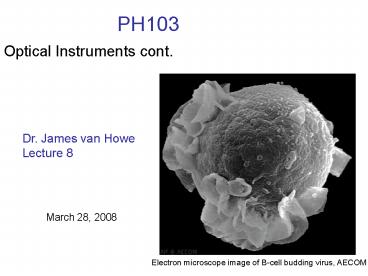Optical Instruments cont' PowerPoint PPT Presentation
1 / 16
Title: Optical Instruments cont'
1
PH103
Optical Instruments cont.
Dr. James van Howe Lecture 8
March 28, 2008
Electron microscope image of B-cell budding
virus, AECOM
2
How many languages are spoken worldwide (not
including dialects)?
- 500
- 5,000
- 50,000
- 500,000
3
True or False
In a telescope, increasing the focal length of
the objective lens increases the angular
magnification
4
True or False
In a microscope, increasing the focal length of
the objective lens increases the angular
magnification
5
Angular size
We know distant stars are enormous (sun 106 km
wide), but they seem small
Radians!!!
This is related to what we call the angular size,
h
dfar
One way to make an object seem bigger is to bring
it closer to your eye
h
dclose
Angular size depends on 1. size of the object,
h 2.
distance d, from your eye
To make the object seem the biggest, bring as
close as possible to your eye
Limitation to see the object clearly, you cant
go closer than near point, N
6
Angular Magnification Simple Magnifier
o
o
Lens allows you to cheat. You can put an object
closer than your near point, like inside the
focal length of a converging lens.
Naked eye best you can do is the near point, N
Angular size
Angular size
For simple magnifier
Lens compared to naked eye
7
Simple Magnifier Special Case 1
Relaxed Eye
Looking at infinity (image), object at the focus
8
Simple Magnifier Special Case 2
Strained Eye
Looking at near point (image)
1 extra from case 1
9
Simple Compound Microscope
Lens combination
Sample approximately at focus of objective,
imaged to infinity by eyepiece
Lens 1 Case 1. on your sheet
Lens 2 Simple Magnifier
10
Microscope Magnification
Since objective is a non-infinity imaged simple
case, we can use old rules
If
11
Numerical Aperture
Microscope
Collection Efficiency of Objective Lens
D, diamter of lens
If angle is small,
If the collection cone of light is larger (larger
NA) the lens collects photons more efficiently
from the sample. Youll need less time to see a
clear image (fast lens).
Larger lens and smaller focal length, the higher
the collection efficiency, larger NA
12
Similar Figure of Merit for Cameras and Telescopes
f-stop is a measure of the amount of light
reaching the film, or CCD display on digital
camera (inverse of NA)
Larger lens and smaller focal length, the higher
the collection efficiency, smaller the f-stop
-The lower the f-stop, the less time you need the
shutter of your camera to be open, the faster the
lens
Light gathering power of a lens
If you increase the aperture D by 2x, you only
need ¼ of the time for shutter speed
13
Camera
-In a camera, the film is fixed in position
-Unlike your eyeball, the focal length cannot
change adaptively
So how do you focus on objects at different
distances?
Lens moves back and forth laterally
Since the focal length doesnt change, only way
to change f-stop is through stopping the diameter
D (for fully open iris D25 mm typically)
F-stop is really just read-off on a camera as a
change in diameter
1.0, 1.4, 2.0, 2.8, 4.0, 5.6, 8, 11, 16, 22, 32
most open
most closed
14
Camera f-stop
If taking a picture at f-stop 1.0 requires
1/400th of a second for a nice picture, changing
to f-stop 2.0 requires 1/100th of a second, four
time slower
Smaller Aperture (diameter)
Case 1
Case 2
One-fourth the light means I need 4x longer open
shutter
15
Also use f-stop to characterize telescope
As you magnify distance galaxies or planets,
light is spread out over a large magnified
image-hard to see if your lens is not efficient
16
Difference between types of objects
Extended object like a planet or galaxy so that
when viewed through a lens magnifies to show
detail
Distant point source (like a distant star) Just
looks the same through the lens, no real
magnification
Focus of the lens is not helping us magnify
detail so we can ignore it

